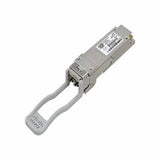Cisco QSFP-40G-SR-BD BiDirectional (40G BiDi) Module
High-performance of Multi Mode Transceiver
The QSFP-40G-SR-BD is a Cisco QSFP+ transceiver module that is designed to provide high-speed, multi-mode fiber connectivity for networking equipment. It is capable of transmitting data at speeds of up to 40 GBPS over multi-mode fiber-optic cables. The module has a reach of up to 100 meters on OM3 fiber or 150 meters on OM4 fiber, making it well-suited for use in short- to medium-distance applications. The QSFP-40G-SR-BD is compatible with a variety of networking equipment, including switches, routers, and servers, and it supports a range of industry-standard protocols such as IEEE 802.3ba and Fibre Channel. Overall, the QSFP-40G-SR-BD is a high-performance transceiver module that is well-suited for use in a variety of networking applications.Interference Mitigation Techniques
The QSFP-40G-SR-BD Cisco QSFP+ Multi Mode Transceiver Module is a high-performance optical module designed for short-range data transmission in data center and enterprise networks. Interference can be a common issue in high-density network environments, especially when multiple transceiver modules are installed in close proximity to each other. Here are some interference mitigation techniques that can be used with the QSFP-40G-SR-BD transceiver module:
- Dynamic Channel Equalization (DCE): This technique is used to compensate for optical losses and wavelength drifts caused by environmental factors such as temperature changes and aging. DCE can adjust the laser output power and receiver sensitivity to optimize the optical signal quality and minimize interference.
- Receiver Optical Subassembly (ROSA): ROSA is a receiver module that incorporates a high-sensitivity photodiode and a low-noise preamplifier to convert the optical signal into an electrical signal with minimal noise and distortion. ROSA can also compensate for signal degradation caused by reflections and other interference sources.
- Transmitter Optical Subassembly (TOSA): TOSA is a transmitter module that integrates a laser diode, a modulator, and a driver amplifier to generate a high-quality optical signal with minimal jitter and distortion. TOSA can also compensate for signal degradation caused by reflections and other interference sources.
- Enhanced Digital Diagnostics Monitoring (DDM): DDM is a feature that provides real-time monitoring of the transceiver module's performance parameters such as temperature, voltage, and optical power. DDM can detect abnormal conditions that may cause interference and alert the network administrator to take corrective action.
- Automatic Power Control (APC): APC is a feedback mechanism that adjusts the laser output power to maintain a constant optical power level at the receiver. APC can compensate for signal attenuation caused by fiber length and connector losses, and can also reduce interference caused by neighboring transceivers.
- Wavelength Division Multiplexing (WDM): WDM is a technique that allows multiple optical signals to be transmitted simultaneously over a single fiber by using different wavelengths. WDM can increase the network capacity and reduce interference by separating the signals into distinct channels.
System Integration of QSFP Transceiver
The QSFP-40G-SR-BD is a Cisco QSFP+ Multi-Mode Transceiver Module that is designed to support high-speed data transmission at a rate of 40Gbps. It uses the QSFP+ interface and is compatible with Ethernet and Infiniband applications.
System integration of the QSFP-40G-SR-BD involves connecting the transceiver module to other network components such as switches, routers, and servers. This can be achieved using fiber optic cables, which are typically designed to support multi-mode transmissions.
The QSFP-40G-SR-BD is a bidirectional transceiver module that supports transmission over a single fiber optic cable. It uses two wavelengths (850nm and 900nm) to transmit and receive data, and it supports distances of up to 150 meters over OM4 multimode fiber.
To integrate the QSFP-40G-SR-BD into a network system, it is important to ensure that the transceiver module is compatible with other network components. This includes checking for compatibility with the switch or router, as well as ensuring that the fiber optic cable and connectors are appropriate for the module.
Once the QSFP-40G-SR-BD is connected to the network, it can be configured using the appropriate software or firmware. This may involve setting the appropriate transmission speed, configuring VLANs or other network settings, and ensuring that the transceiver is operating correctly.
Main Specification about this Cisco QSFP-40G-SR-BD
- Manufacturer: Cisco
- Model Number or SKU# QSFP-40G-SR-BD
- Product Line Legrand
- Product Type: QSFP+ Transceiver Module
Technical Information of Transceiver Module
- Transceiver Type: BX
- Reach: 150m
- Connector: Duplex LC
- Wavelength: 832nm to 918nm
- Media: MMF
- Application/Usage Optical Network
- Application/Usage Data Networking
Performance for QSFP+ Multi-Mode Transceiver
- Data Link Protocol: 40 Gigabit LAN
- Data Transfer Rate: 40 GBPS
- Optical Wave Length: 850 nm
- Max Transfer Distance: 492 Feet
Power Description
- Transmitter Power: -4~5dBm
- Receiver Sensitivity :<-6dBm
- Powerbudget: 6dB
- Power Consumption: 3.5 Watt
- Extinction Ratio: 3.5dB
Environmental Parameters
- Min Operating Temperature: 50 °F
- Max Operating Temperature: 158 °F
- Humidity Range Operating: 5 - 95%
Dimensions & Weight
- Form Factor: Hot-swappable
- Height: 0.5 Inch
- Width: 0.7 Inch
- Depth: 2.9 Inch
Compatibility
- Cisco Nexus 9000 Series Switches are compatible with MSA (Multi-Source Agreement) standards.
- They are also compliant with green standards.
- The switches have received RoHS-6 certification as proof of their compliance with environmental regulations.




